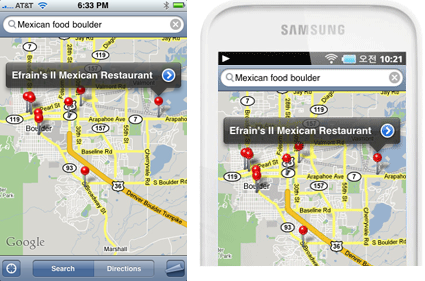Samsung accused of lifting iPhone screenshot for Galaxy Player promo
John Gruber of Daring Fireball noted on Monday (via Jeremy Philippe) that Samsung appeared to be using a maps interface that was an "ever-so-slightly modified rip-off" of the Maps application on Apple's iPhone for a promotional image of the Galaxy Player 50 on its website. However, it was quickly revealed that the interface shown on the device is actually an exact copy of an iPhone screenshot from a blog post by Laura Scott on BlogHer in 2008.
AppleInsider originally posted Samsung's pilfered iOS graphic last month in an article on GameStop's Android gaming tablet plans and other attempts by Apple's competitors to muscle into mobile devices beyond the smartphone, including the Galaxy Player's attempt to rival iPod touch.
Marketing staffers have frequently taken photographs portraying Apple's Mac products and replaced the screen with a Windows screenshot, or as Nokia did this summer, simply use stock photography of a woman using the iPhone 4 and emblazon the shot with a Nokia banner to produce a generic ad.
Samsung's use of an old iOS Maps screenshot (evidently pulled from a Google image search) is particularly egregious because the graphic was purposely edited to incorporate an Android task bar in order to appear to be a feature of Google's platform, and then used to market Galaxy Player as an alternative to Apple's original iPod touch.
The issue is further complicated by the fact that Apple is already accusing Samsung of "slavishly" copying the design of its iPhone and iPad its own products.
Samsung's line of Galaxy Player devices, announced last year, was widely viewed as the company's response to Apple's successful iPod touch, which blends the iPhone with Apple's line of iPod music players.
Left, iPhone screenshot (via Flickr); Right, Samsung promotional image.
The South Korean consumer electronics giant has recently faced several setbacks in its legal dispute with Apple. Late last week, a Netherlands judge denied the company's request to block sales of the iPhone and the iPad in the country. In contrast, Apple in August successfully convinced a Dutch judge to order an injunction against three of Samsung's smartphones.
The Federal Court in Australia recently issued a preliminary injunction against Samsung's Galaxy Tab 10.1 tablet after Apple assert several of its patents related to touchscreen and multitouch technologies. The ruling came on the heels of a similar decision in Germany that blocked the device.
Samsung could also face injunctions on Apple's home turf. Last week, a Samsung lawyer was unable to distinguish between the Galaxy Tab 10.1 and the iPad at a distance of 10 feet during a court hearing. U.S. District Judge Lucy Koh has yet to issue a ruling on the matter, but she has said that she believes the Galaxy tablets do infringe on some of Apple's iPad-related patents. However, Apple must still show that those patents are valid in order to win its case against its rival.
After Apple raised concerns with its rival last year, the matter went unresolved, prompting the iPhone maker to turn to the courts for help. The Cupertino, Calif., company first sued Samsung in April, and the disagreement quickly escalated, spanning more than 20 complaints across 10 countries.
Apple continues to maintain that the resemblance of Samsung's products to its own amounts to theft. "It's no coincidence that Samsung's latest products look a lot like the iPhone and iPad ... This kind of blatant copying is wrong, and we need to protect Apple's intellectual property when companies steal our ideas," an Apple spokeswoman was reported as saying last week.
In September, Samsung was accused of borrowing Apple's Safari and App Store icons to decorate the wall of a mini-store in an Italian mall after photos of the store emerged, but it turned out that the wall was actually part of the larger store's design.
 Josh Ong
Josh Ong











 William Gallagher and Mike Wuerthele
William Gallagher and Mike Wuerthele
 Christine McKee
Christine McKee
 William Gallagher
William Gallagher
 Malcolm Owen
Malcolm Owen
 Marko Zivkovic
Marko Zivkovic


 Wesley Hilliard
Wesley Hilliard






